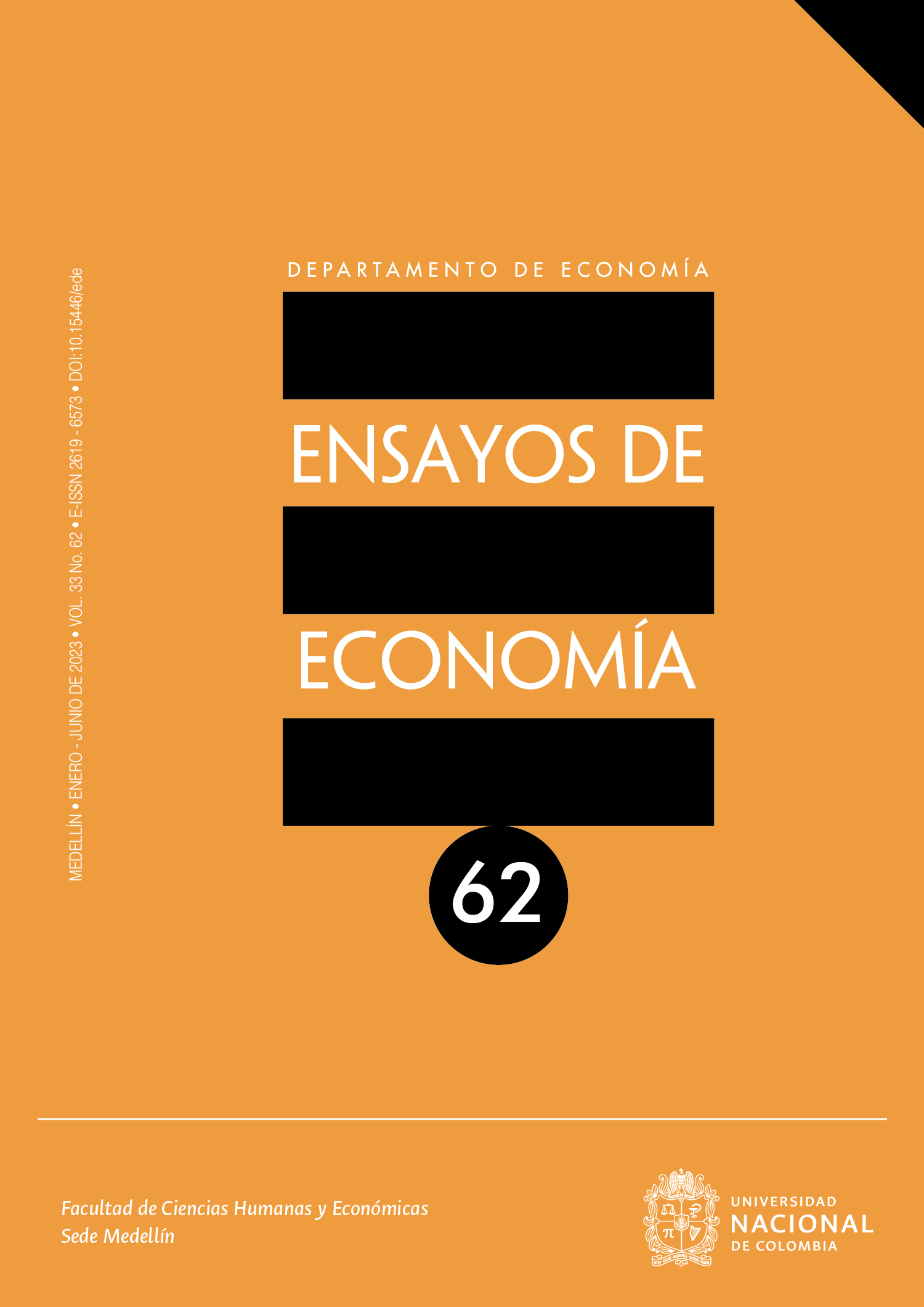Evolución de los esquemas de política monetaria
Evolution of monetary policy schemes
DOI:
https://doi.org/10.15446/ede.v33n62.98494Palabras clave:
Política Monetaria, Economía Monetaria, Esquemas de Monitoreo, Instrumentos de política (es)Monetary Policy, Monetary Economics, Monitoring Schemes, Policy Instruments (en)
Descargas
En este artículo se revisa los esquemas de política monetaria que emplea un banco central para estabilizar una economía. Para cumplir con este objetivo, se examinan diferentes enfoques conceptuales como la tasa de interés real neutral (TIRN), enfoque de inflación objetivo, enfoque de flexibilidad cuantitativa, visiones de Stiglitz (2010) y Krugman (2017) sobre política monetaria y las recientes perspectivas de data dependence, market intelligence y Risk Management. A su vez, sintetiza los esquemas de política monetaria en una propuesta que plantea un esquema de monitoreo de pleno empleo con estabilidad económica y financiera.
This article reviews the monetary policy schemes that a central bank employs to stabilize an economy. To achieve this objective, different conceptual approaches are reviewed, such as the Neutral Real Interest Rate (IRRN), objective inflation approach, quantitative flexibility approach, views of Stiglitz (2010) and Krugman (2017) on monetary policy and the recent perspectives of data dependency, market intelligence and Risk Management. Furthermore, it synthesizes the monetary policy schemes in a proposal that raises a monitoring scheme for full employment with economic and financial stability.
Referencias
Ahmed, S., & Zlate, A. (2014). Capital Flows to Emerging Market Economies: A Brave New World? Journal of International Money and Finance, 48, 221-248. https://doi.org/10.1016/j.jimonfin.2014.05.015
Akerlof, G., Dickens, W., Perry, G., Gordon, R., & Mankiw, N. (1996). The Macroeconomics of Low Inflation. Brookings Papers on Economic Activity, 1996(1), 1-76. https://doi.org/10.2307/2534646
Arestis, P., & Sawyer, M. C. (2002). Can Monetary Policy Affect The Real Economy? [Working Paper No. 355]. Levy Economics Institute http://dx.doi.org/10.2139/ssrn.335620
Banco Central Europeo (2004). Monthly Bulletin May. https://www.ecb.europa.eu/pub/pdf/mobu/mb200405en.pdf
Bauer, M. D., & Neely, C. J. (2014). International Channels of the Fed‘s Unconventional Monetary Policy. Journal of International Money and Finance, 44, 24-46. https://doi.org/10.1016/j.jimonfin.2013.12.007
Bowman, D., Londoño, J., & Sapriza, H. (2015). U.S. Unconventional Monetary Policy and Transmission to Emerging Market Economies. Journal of International Money and Finance, 55, 27-59. https://doi.org/10.1016/j.jimonfin.2015.02.016
Bullard, J. (2016). What Does Data Dependence Mean? The Regional Economist. 24(1), 3. https://www.stlouisfed.org/publications/regional-economist/january-2016/what-does-data-dependence-mean
De Marco, F., Kneer, C., & Wieladek, T. (2021). The Real Effects of Capital Requirements and Monetary Policy: Evidence from The United Kingdom. Journal of Banking & Finance, 133, 106-237. https://doi.org/10.1016/j.jbankfin.2021.106237
Fondo Monetario Internacional (2011). Recent Experiences in Managing Capital InflowdCross-cutting Themes and Possible Guidelines [IMF paper]. https://www.imf.org/external/np/pp/eng/2011/021411a.pdf
Fratzscher, M., Lo Duca, M., & Straub, R. (2018). On the International Spillovers of US Quantitative Easing. The Economic Journal, 128(608), 330-377. https://doi.org/10.1111/ecoj.12435
Friedman, M. (1968). The Role of Monetary Policy. The American Economic Review, 58(1), 1-17. https://www.aeaweb.org/aer/top20/58.1.1-17.pdf
Gambacorta, L., Hofmann, B., & Peersman, G. (2014). The Effectiveness of Unconventional Monetary Policy at The Zero Lower Bound: A Cross-Country Analysis. Journal Money Credit Bank, 46 (4), 615–642. https://doi.org/10.1111/jmcb.12119
Glick, R., & Leduc, S. (2013). The Effects of Unconventional and Conventional U.S. Monetary Policy on The Dollar [Working Paper, No. 2013-11]. Federal Reserve Bank of San Francisco. https://www.frbsf.org/economic-research/publications/working-papers/2013/11/ DOI: https://doi.org/10.24148/wp2013-11
Hausken, K., & Ncube, M. (2013). Quantitative easing and its impact in the US, Japan, the UK and Europe. Springer. DOI: https://doi.org/10.1007/978-1-4614-9646-5
Joyce, M., Lasaosa, A., Stevens, I., & Tong, M. (2011). The Financial Market Impact of Quantitative Easing in the United Kingdom. International Journal of Central Banking, 7(3), 113–161. https://www.ijcb.org/journal/ijcb11q3a5.htm
Joyce, M., Tong, M., & Woods, R. (2011). The United Kingdom’s Quantitative Easing Policy: Design, Operation and Impact. Bank of England Quarterly Bulletin, 51(3), 200–212. https://www.bankofengland.co.uk/quarterly-bulletin/2011/q3/the-uk-quantitative-easing-policy-design-operation-and-impact
Keynes, J. M. (1930). Treatise on money: Pure Theory of Money Vol. I. Macmillan.
Keynes, J. M. (1936). Teoría general de la ocupación, el interés y el dinero. Fondo de la Cultura Económica.
Kiley, M. T. (2015). Low Inflation in the United States: A Summary of Recent Research, FEDS Notes. Board of Governors of the Federal Reserve System. https://doi.org/10.17016/2380-7172.1665
Krishnamurthy, A., & Vissing-Jorgensen, A. (2011). The Effects of Quantitative Easing on Interest Rates: Channels and Implications for policy. Brookings Papers on Economic Activity, 2011(2), 215–287. https://www.brookings.edu/wp-content/uploads/2016/07/2011b_bpea_krishnamurthy.pdf DOI: https://doi.org/10.1353/eca.2011.0019
Krugman, P. (2017, 23 de octubre). The Doctrine of Trumpal Infallibility. The New York Times. https://www.nytimes.com/2017/10/23/opinion/federal-reserve-john-taylor.html?ref=nyt-es&mcid=nyt-es&subid=article
Kurihara, Y. (2006). Recent Japanese Monetary Policy: An Evaluation of The Quantitative Easing. International Journal of Business, 11(1), 79–86. https://ijb.cyut.edu.tw/var/file/10/1010/img/852/V111-6.pdf
Lim, J., Mohapatra, S., & Stocker, M. (2014). Tinker, Taper, QE, Bye? The Effect of Quantitative Easing on Financial Flows to Developing Countries [Policy Research Working Paper, No. 6820]. http://hdl.handle.net/10986/17733 DOI: https://doi.org/10.1596/1813-9450-6820
Mallick, S. K., & Sousa, R. M. (2012). Real Effects of Monetary Policy in Large Emerging Economies. Macroeconomic Dynamics, 16(S2), 190-212. https://doi.org/10.1017/S1365100511000319
Minsky, H. P. (1982). Can “It” Happen Again? Essays on Instability and Finance. ME Sharpe. DOI: https://doi.org/10.1080/05775132.1982.11470774
Moore, B. (1988). Horizontalists and Verticalists: The Macroeconomics of Credit Money. Cambridge University Press.
Moore, B. (1989). On the endogeneity of money once more. Journal of Keynesian Economics, 11(3), 479-487. http://www.jstor.org/stable/4538146 DOI: https://doi.org/10.1080/01603477.1989.11489756
Moore, J., Nam, S., Suh, M., & Tepper, A. (2013). Estimating The Impacts of US LSAP‘s on Emerging Market Economies‘ Local Currency Bond Markets [Working Paper, No. 595]. Federal Reserve Bank of New York. https://www.newyorkfed.org/research/staff_reports/sr595.html
Neely, C. J. (2015). Unconventional Monetary Policy Had Large International Effects. Journal of Banking & Finance, 52, 101-111. https://doi.org/10.1016/j.jbankfin.2014.11.019
Patterson, L. (2017, 28 de junio). Markets Calling: Intelligence Gathering at the Bank of Canada [discurso]. Sociedad CFA de Calgary, Alberta, Canadá. https://www.bankofcanada.ca/2017/06/markets-calling-intelligence-gathering-bank-canada/
Poloz, S. S. (2017, 27 de septiembre). The Meaning of “Data Dependence”. An Economic Progress Report [comunicado de prensa]. https://www.bankofcanada.ca/2017/09/meaning-data-dependence-economic-progress-report/
Poole, W. (2007). Data Dependence. Federal Reserve Bank of St. Louis Review, 89(2), 77-83. https://doi.org/10.20955/r.89.77-84
Powell, J. H. (2018, 24 de agosto). Monetary Policy in a Changing Economy [Discurso principal]. Simposio Changing Market Structures and Implications for Monetary Policy, Jackson Hole, Wyoming, Estados Unidos. https://www.federalreserve.gov/newsevents/speech/powell20180824a.htm
Pyle, B., & Williams, J. C. (2016). Data Dependence Awakens. FRBSF Economic Letters, 12, 1-5. https://www.frbsf.org/economic-research/publications/economic-letter/2016/april/data-dependence-awakens-monetary-policy/
Stiglitz, J. E. (2010). La caída Libre. El libre mercado y el hundimiento de la economía mundial. Taurus.
Svensson, L. E., & Woodford, M. (2003). Indicator variables for optimal policy. Journal of Monetary Economics, 50(3), 691-720. https://doi.org/10.1016/S0304-3932(03)00030-8
Swanson, E. T., & Williams, J. C. (2014). Measuring the Effect of the Zero Lower Bound on Medium- and Longer-Term Interest Rates. American Economic Review 104(10), 3154-3185. https://doi.org/10.1257/aer.104.10.3154
Taylor, J. (1993). Discretion vs Policy Rules in Practice. Carnegie-Rochester Conference Series on Public Policy,39, 195-214. https://doi.org/10.1016/0167-2231(93)90009-L
Tillmann, P. (2016). Unconventional Monetary Policy and The Spillovers to Emerging Markets. Journal of International Money and Finance, 66, 136-156. https://doi.org/10.1016/j.jimonfin.2015.12.010
Ugai, H. (2006). Effects of The Quantitative Easing Policy: A Survey of Empirical Analyses [Bank of Japan Working Paper Series Working Paper, No. 06-E-10]. https://www.imes.boj.or.jp/research/papers/english/me25-1-1.pdf
Wicksell, K. (1898). Interest and Prices. Royal Economic Society.
Wolf, C. K. (2020). Svar (Mis) identification and The Real Effects of Monetary Policy Shocks. American Economic Journal: Macroeconomics, 12(4), 1-32. https://doi.org/10.1257/mac.20180328
Woodford, M. (2001). Imperfect Common Knowledge and The Effects of Monetary Policy [NBER Working Paper No. 8673]. https://doi.org/10.3386/w8673
Cómo citar
APA
ACM
ACS
ABNT
Chicago
Harvard
IEEE
MLA
Turabian
Vancouver
Descargar cita
Licencia

Esta obra está bajo una licencia internacional Creative Commons Atribución-NoComercial-SinDerivadas 4.0.
Se autoriza la reproducción sin ánimo de lucro de los materiales, citando la fuente.



























